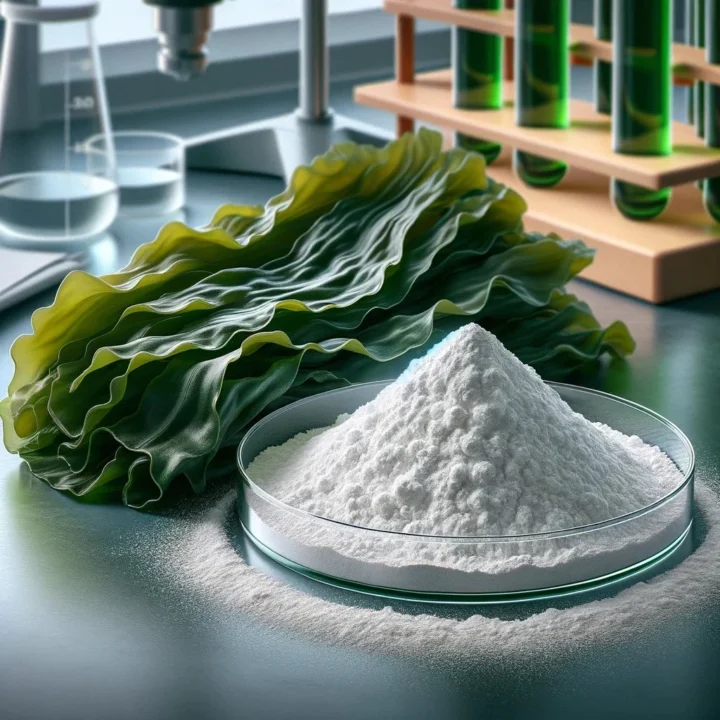Food additives have become an indispensable part of modern cuisine, providing us with various textures, flavors, and appearances in our favorite meals. One such versatile additive is sodium alginate, an organic compound extracted from seaweed. In this comprehensive guide on sodium alginate, you will learn its source, benefits, and effects on our meals.
What Is Sodium Alginate?
Sodium alginate is a polysaccharide compound made from brown seaweeds like Laminaria hyperborea and Macrocystis pyrifera that contain high concentrations of alginate in their cell walls, providing an invaluable source of this compound. Once extracted and processed, sodium alginate forms an easily dissolved powder that dissolves quickly in water.
The Science Behind Sodium Alginate
At its core, sodium alginate is a linear copolymer composed of two monosaccharides: mannuronic acid and guluronic acid. These monosaccharides are arranged in blocks within the polymer chain, creating distinct regions of alternating mannuronic and guluronic acid residues.
The unique arrangement of these monosaccharides plays an integral part in sodium alginate’s behavior in solutions. When dispersed into water, sodium alginate forms a viscous solution due to its ability to hydrate water molecules, but its most astonishing property lies in its gelling property when exposed to calcium ions.
Gelation Mechanism
The gelation mechanism of sodium alginate depends on exchanging sodium ions within its chain for calcium ions from surrounding solutions, specifically calcium chloride (CaCl2). Calcium has a greater affinity for the guluronic acid residues found within alginate chains than sodium does; when exposed to CaCl2 solution or something similar, calcium replaces sodium along the polymer chain and forms crosslinks between nearby molecules, creating its characteristic three-dimensional gel network that gives sodium alginate its characteristic gel-like texture.
This unique gelation property is at the heart of many of sodium alginate’s applications in the food industry. By controlling the concentration of calcium ions and the duration of exposure, food scientists can manipulate the texture and consistency of food products, creating gels, spheres, and other novel textures.
Applications In The Food Industry
Sodium alginate finds widespread use in the food industry due to its diverse functional properties. Let’s explore some of the key applications:
1. Thickening Agent
Sodium alginate plays a key role in food by acting as a thickening agent. By adding sodium alginate to liquid, its viscosity increases, creating a thicker consistency, which is particularly helpful for sauces, dressings, and soups that rely on having an attractive texture for desired eating experiences. Its use won’t alter their flavors or aroma either.
2. Gel Formation
Due to sodium alginate’s gelation properties, its gels and jellies can be an integral component in creating mouthwatering desserts and confections, as well as savory dishes with unique mouthfeel and presentation. By carefully controlling calcium ion concentration levels, chefs and food scientists can craft gels of various textures and strengths for use in desserts, confections, or even savory dishes for enhanced sensory experiences and presentations.
3. Spherification
Sodium alginate has become best known for its role in molecular gastronomy, specifically spherification. Spherification involves creating small “caviar-like” beads or larger spheres filled with flavorful liquids, revolutionizing culinary creation while simultaneously encapsulating flavors into visually stunning dishes.
Spherification involves creating a sodium alginate solution and adding it to a flavorful liquid before dropping this concoction in a bath of calcium chloride, where sodium alginate gelation takes place and forms a thin membrane around it. The result: delicate yet burst-in-your-mouth experiences that take dishes to new levels.
4. Stabilizer And Emulsifier
Sodium alginate serves as an efficient stabilizer and emulsifier in various food products, from salad dressings and ice creams to other emulsified items like smoothies. By preventing oil and water phases from dissociating during storage, sodium alginate helps ensure these items maintain their desired texture and consistency throughout their shelf lives.
5. Fat Replacement
Sodium alginate can provide healthier food options by serving as a fat replacer, making products with reduced-fat or no-fat ingredients more appealing to consumers who are mindful of their fatty intake.
6. Encapsulation Of Nutrients
Utilizing sodium alginate for the encapsulation of nutrients and bioactive chemicals is yet another novel application of this substance in the food business. By encapsulating vitamins, minerals, and other useful compounds within sodium alginate capsules, it is possible to shield these nutrients from destruction and release them gradually in the digestive system, therefore increasing their bioavailability.
The Role Of Sodium Alginate In Culinary Innovation
Sodium alginate’s unique properties have opened a world of culinary innovation to chefs, enabling them to push beyond traditional recipes. Here are a few examples of its use in creative dishes:
1. Molecular Gastronomy
Molecular gastronomy is a culinary movement that explores the science of cooking, and sodium alginate plays a pivotal role in this field. Chefs use sodium alginate to create foams, gels, and other intriguing textures that defy traditional culinary norms. Dishes are transformed into artistic creations, and the dining experience becomes an adventure in taste and texture.
2. Artistic Plating
Sodium alginate’s ability to create visually appealing textures and shapes has led to a surge in artistic plating techniques. Chefs can use sodium alginate to craft delicate spheres, sheets, and edible art pieces that add aesthetic value to their creations.
3. Flavor Pairing
Sodium alginate allows chefs to experiment with flavor pairings in novel ways. By encapsulating complementary flavors within sodium alginate spheres, they can surprise diners with unexpected bursts of taste and aroma in each bite.
4. Texture Modification
Chefs and food scientists can manipulate the texture of various ingredients using sodium alginate. Whether it’s making fruit caviar, transforming liquids into solids, or creating unique mouthfeels, sodium alginate enables chefs to redefine the sensory experience of food.
Conclusion
Sodium alginate is a remarkable and versatile food additive that has transformed the way we perceive and experience food. From enhancing texture and flavor to enabling culinary innovation, its applications are boundless. As long as people seek new flavors and food companies are searching for innovative new ideas, sodium alginate will remain an integral component of food science and culinary practices.
As you explore sodium alginate, remember that its responsible and creative use can bring extraordinary culinary experiences. So the next time you come across an unusual texture, delicious flavor burst or visually captivating presentation in your food, sodium alginate may well be behind its magic!




